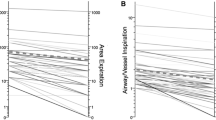Abstract
Ninety-nine patients (29 males and 70 females; mean age, 57.1 years; range, 22–81 years) were included in this study to evaluate the factors affecting smaller lung volume changes in expiratory high-resolution computed tomography performed to depict air trapping. All patients underwent inspiratory and expiratory chest thin-section CT examinations and pulmonary function tests. Air trapping on CT images was graded subjectively. All variables (age, sex, diagnosis, pulmonary function index, and air trapping score) were compared with the degree of change in lung volume between the inspiratory and expiratory CT examinations. The variables affecting a lower degree of volume change were vital capacity, forced vital capacity (FVC), forced expiratory volume in 1 s (FEV1.0), and the FEV1.0/FVC ratio. Bronchiolitis obliterans was the dominant diagnosis in patients with insufficient degrees of breath holding and in patients with negative air trapping scores despite an abnormal air trapping index. An insufficient degree of lung changes between inspiration and expiration on CT examinations represented bronchiolitis obliterans, which resulted in low FEV1.0 and FEV1.0/FVC values. Changes in the time gap from the announcement of exhalation and breath holding to the start of scanning most effectively indicated air trapping in patients with bronchiolar disorders.







Similar content being viewed by others
References
Devakonda A, Raoof S, Sung A, Travis WD, Naidich D. Bronchiolar disorders: a clinical-radiological diagnostic algorithm. Chest. 2010;137:938–51.
Arakawa H, Webb WR, McCowin M, Katsou G, Lee KN, Seitz RF. Inhomogeneous lung attenuation at thin-section CT: diagnostic value of expiratory scans. Radiology. 1998;206(1):89–94.
Arakawa H, Gevenois PA, Saito Y, Shida H, De Maertelaer V, Morikubo H, Fujioka M. Silicosis: expiratory thin-section CT assessment of airway obstruction. Radiology. 2005;236:1059–66.
Stern EJ, Müller NL, Swensen SJ, Hartman TE. CT mosaic pattern of lung attenuation: etiologies and terminology. J Thorac Imaging. 1995;10:294–7.
Arakawa H, Webb WR. Air trapping on expiratory high-resolution CT scans in the absence of inspiratory scan abnormalities: correlation with pulmonary function tests and differential diagnosis. AJR Am J Roentgenol. 1998;170(5):1349–53.
Bankier AA, Mehrain S, Kienzl D, Weber M, Estenne M, Gevenois PA. Regional heterogeneity of air trapping at expiratory thin-section CT of patients with bronchiolitis: potential implications for dose reduction and CT protocol planning. Radiology. 2008;247(3):862–70.
Webb WR. High-resolution computed tomography of obstructive lung disease. Radiol Clin North Am. 1994;32(4):745–57.
Gleeson FV, Traill ZC, Hansell DM. Evidence of expiratory CT scans of small-airway obstruction in sarcoidosis. AJR Am J Roentgenol. 1996;166(5):1052–4.
Yang CF, Wu MT, Chiang AA, Lai RS, Chen C, Tiao WM, McLoud TC, Wang JS, Pan HB. Correlation of high-resolution CT and pulmonary function in bronchiolitis obliterans: a study based on 24 patients associated with consumption of Sauropus androgynus. AJR Am J Roentgenol. 1997;168:1045–50.
Eber CD, Stark P, Bertozzi P. Bronchiolitis obliterans on high-resolution CT: a pattern of mosaic oligemia. J Comput Assist Tomogr. 1993;17(6):853–6.
Standardization of spirometry, 1994 update. American Thoracic Society. Am J Respir Crit Care Med. (1995);152(3):1107–36
Lee ES, Gotway MB, Reddy GP, Golden JA, Keith FM, Webb WR. Early bronchiolitis obliterans following lung transplantation: accuracy of expiratory thin-section CT for diagnosis. Radiology. 2000;216:472–7.
Hansell DM, Rubens MB, Padley SP, Wells AU. Obliterative bronchiolitis: individual CT signs of small airways disease and functional correlation. Radiology. 1997;203:721–6.
Bankier AA, Van Muylem A, Knoop C, Estenne M, Gevenois PA. Bronchiolitis obliterans syndrome in heart–lung transplant recipients: diagnosis with expiratory CT. Radiology. 2001;218(2):533–9.
Sweatman MC, Millar AB, Strickland B, Turner-Warwick M. Computed tomography in adult obliterative bronchiolitis. Clin Radiol. 1990;42(2):116–9.
Grenier PA, Beigelman-Aubry C, Fétita C, Prêteux F, Brauner MW, Lenoir S. New frontiers in CT imaging of airway disease. Eur Radiol. 2002;12:1022–44.
Busacker A, Newell JD Jr, Keefe T, Hoffman EA, Granroth JC, Castro M, Fain S, Wenzel S. A multivariate analysis of risk factors for the air-trapping asthmatic phenotype as measured by quantitative CT analysis. Chest. 2009;135:48–56.
Verschakelen JA, Scheinbaum K, Bogaert J, Demedts M, Lacquet LL, Baert AL. Expiratory CT in cigarette smokers: correlation between areas of decreased lung attenuation, pulmonary function tests and smoking history. Eur Radiol. 1998;8(8):1391–9.
Bankier AA, Estenne M, Kienzl D, Müller-Mang C, Van Muylem A, Gevenois PA. Gravitational gradients in expiratory computed tomography examinations of patients with small airways disease: effect of body position on extent of air trapping. J Thorac Imaging. 2010;25(4):311–9.
Epler GR, Colby TV. The spectrum of bronchiolitis obliterans. Chest. 1983;83(2):161–2.
Padley SP, Adler BD, Hansell DM, Müller NL. Bronchiolitis obliterans: high resolution CT findings and correlation with pulmonary function tests. Clin Radiol. 1993;47(4):236–40.
Pryor JA, AmmanlPrasad S. Physiotherapy for respiratory and cardiac problems: adults and paediatrics. London: Churchill lingstone; 2008. p. 51–72.
Acknowledgments
This report was presented orally at the 66th Annual Scientific Congress of the Japanese Society of Radiological Technology and was recommended for publication by the chairman.
Conflict of interest
All authors have no direct or indirect financial interest in the products under investigation or subject matter discussed in this manuscript.
Author information
Authors and Affiliations
Corresponding author
About this article
Cite this article
Morikawa, K., Okada, F. & Mori, H. Expiratory computed tomographic techniques: A cause of a poor rate of change in lung volume. Radiol Phys Technol 8, 153–159 (2015). https://doi.org/10.1007/s12194-014-0304-z
Received:
Revised:
Accepted:
Published:
Issue Date:
DOI: https://doi.org/10.1007/s12194-014-0304-z




